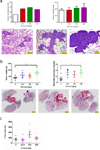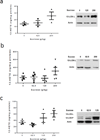A Sucrose-Enriched Diet Promotes Tumorigenesis in Mammary Gland in Part through the 12-Lipoxygenase Pathway
- PMID: 26729790
- PMCID: PMC4703949
- DOI: 10.1158/0008-5472.CAN-14-3432
A Sucrose-Enriched Diet Promotes Tumorigenesis in Mammary Gland in Part through the 12-Lipoxygenase Pathway
Abstract
Epidemiologic studies have shown that dietary sugar intake has a significant impact on the development of breast cancer. One proposed mechanism for how sugar impacts cancer development involves inflammation. In the current study, we investigated the impact of dietary sugar on mammary gland tumor development in multiple mouse models, along with mechanisms that may be involved. We found that sucrose intake in mice comparable with levels of Western diets led to increased tumor growth and metastasis, when compared with a nonsugar starch diet. This effect was ascribed in part to increased expression of 12-lipoxygenase (12-LOX) and its arachidonate metabolite 12-hydroxy-5Z,8Z,10E,14Z-eicosatetraenoic acid (12-HETE). We determined that fructose derived from the sucrose was responsible for facilitating lung metastasis and 12-HETE production in breast tumors. Overall, our data suggested that dietary sugar induces 12-LOX signaling to increase risks of breast cancer development and metastasis.
©2016 American Association for Cancer Research.
Conflict of interest statement
The authors declare that they have no conflicts of interest.
Figures



References
-
- Romieu I, Ferrari P, Rinaldi S, Slimani N, Jenab M, Olsen A, et al. Dietary glycemic index and glycemic load and breast cancer risk in the European Prospective Investigation into Cancer and Nutrition (EPIC) Am J Clin Nutr. 2012;96:345–355. - PubMed
-
- Dong JY, Qin LQ. Dietary glycemic index, glycemic load, and risk of breast cancer: meta-analysis of prospective cohort studies. Breast Cancer Res Treat. 2011;126:287–294. - PubMed
-
- Larsson SC, Bergkvist L, Wolk A. Glycemic load, glycemic index and breast cancer risk in a prospective cohort of Swedish women. Int J Cancer. 2009;125:153–157. - PubMed
-
- USDA's Economic Research Service. http://www.ers.usda.gov/data-products/food-availability-(per-capita)-dat....
-
- Miller PE, McKinnon RA, Krebs-Smith SM, Subar AF, Chriqui J, Kahle L, et al. Sugar-sweetened beverage consumption in the U.S.: novel assessment methodology. Am J Prev Med. 2013;45:416–421. - PubMed
Publication types
MeSH terms
Substances
Grants and funding
LinkOut - more resources
Full Text Sources
Other Literature Sources
Medical
Molecular Biology Databases

